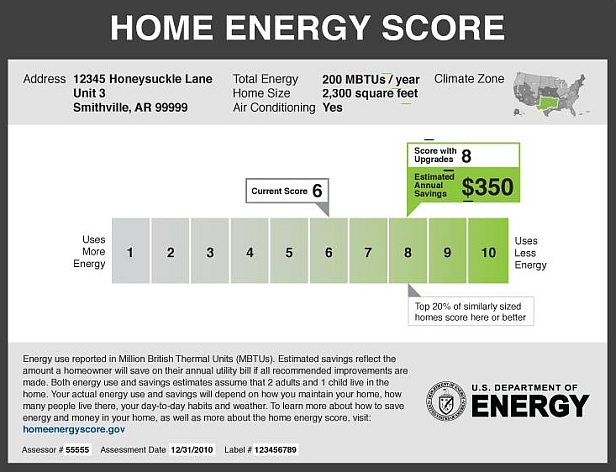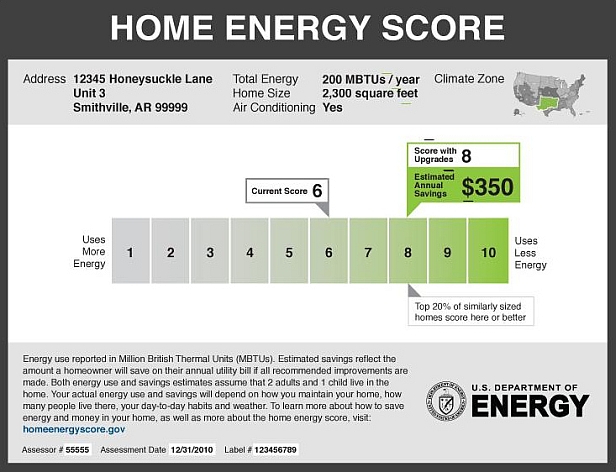Miles-per-gallon ratings provide a quick way to evaluate a vehicle’s performance. Walk Score provides a quick way to evaluate a neighborhood’s performance. Neither standard is perfect, but both are useful for helping people get their heads around the concepts of fuel efficiency and walkability.
Now we’ve got a comparable tool for sizing up a home’s energy performance, the Home Energy Score released today by the Department of Energy (DOE). The score gives a simple 1-10 rating of a dwelling’s energy performance and then — this is the exciting part! — a higher score owners might achieve if they take recommended steps like adding insulation, installing a programmable thermostat, shutting down the steel refinery in their basement, etc. So a home might achieve a 6 and have an expected upgraded score of 8.
The new scoring tool is one of three initiatives announced by the DOE and Vice President Joe Biden’s Middle Class Task Force. I’ll run through the parts briefly:
1. Home Energy Score: Current home-energy inspections can cost upwards of $300 — not exactly inviting for cash-strapped families. New DOE software lets trained auditors walk through a home, assess energy components like furnaces and ducts, complete a digital form, and produce a report like the one above — all in an hour or so, the DOE says. The quicker, streamlined approach should drive down costs for homeowners who hire those inspectors.
Nine regions will test out the score before it’s rolled out national next summer: Charlottesville, Va.; Allegheny County, Penn.; Cape Cod and Martha’s Vineyard, Mass.; Minnesota; Omaha and Lincoln, Neb.; Indiana; Portland, Ore.; South Carolina; Texas; and Eagle County, Colo. (more info on them).
Next is the matter of paying for improvements.
2. PowerSaver low-cost loans: A new financing program will let homeowners seek federally insured loans of up to $25,000 at or below market rates (which are crazy low at the moment). That will help pay for things like insulation, duct sealing, and, potentially, solar panels — things that pay for themselves over time but have high up-front costs.
“PowerSaver will help more homeowners afford common sense, cost saving improvements to their homes, and will create jobs for contractors, installers and energy auditors across the country,” Housing and Urban Development Secretary Shaun said in a news release.
PowerSaver will get $25 million in a two-year pilot run by HUD’s Federal Housing Administration. Now that the innovative efficiency financing model Property Assessed Clean Energy has been suspended by Fannie Mae and Freddie Mac, the loan program provides a key work-around to the problem of upfront costs.
Note: The loans are for single-family homes only; apartment and condo dwellers don’t get to join the party.
3. Quality-control guidelines for contractors: Finally, the DOE released a draft of voluntary guidelines for home-energy workers. That’s useful, since, if you’re letting people into your home to mess with your ducts and HVAC system, it’s nice if they know what they’re doing. (Contractor standards were a concern of Fannie Mae and Freddie Mac when they refused to play nice with the PACE home-energy tool.)
“Currently, there are not enough well-trained residential energy retrofit workers and not enough green entrepreneurs to expand the home energy efficiency industry,” a White House report said.
Presumably, better quality assurance can help the industry mature and attract more workers. The guidelines will be available for public comment through Jan. 7, 2011, if you’re into that sort of thing.
Home-efficiency investments are what’s known as a “win-win-win,” since they create building-industry jobs, save homeowners money, and help polar bears get laid (er, reduce ice-cap-melting emissions).
Here’s a video of Assistant Secretary for Energy Efficiency and Renewable Energy Cathy Zoi explaining the new program.




